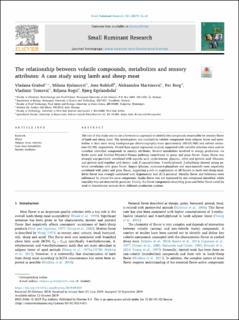| dc.contributor.author | Grabez, Vladana | |
| dc.contributor.author | Bjelanovic, Milena | |
| dc.contributor.author | Rohloff, Jens | |
| dc.contributor.author | Martinovic, Aleksandra | |
| dc.contributor.author | Berg, Per | |
| dc.contributor.author | Tomovic, Vladimir | |
| dc.contributor.author | Rogic, Biljana | |
| dc.contributor.author | Egelandsdal, Bjørg | |
| dc.date.accessioned | 2020-11-16T14:33:53Z | |
| dc.date.available | 2020-11-16T14:33:53Z | |
| dc.date.created | 2019-10-24T13:23:57Z | |
| dc.date.issued | 2019 | |
| dc.identifier.issn | 0921-4488 | |
| dc.identifier.uri | https://hdl.handle.net/11250/2688081 | |
| dc.description.abstract | The aim of this study was to use a flavoromics approach to identify key compounds responsible for sensory flavor of lamb and sheep meat. The investigation was confined to volatile compounds from adipose tissue and metabolites in lean meat using headspace-gas chromatography/mass spectrometry (HS-GC/MS) and solvent extraction-GC/MS, respectively. Partial least square regression analysis supported with variable selection were used to correlate identified compounds to sensory attributes. Several metabolites involved in energy production via Krebs cycle and Embden-Meyerhof-Parnas pathway contributed to gamy and grass flavor. Gamy flavor was strongly and positively correlated with aspartic acid, cyclo-leucine, gluconic, citric and pyruvic acid. Gluconic and pyruvic acid together with formic acid, β-caryophyllene, 3-methylphenol, 2-ethylfuran showed strong positive correlation with grass flavor. Sugars (glucose, mannose-6-phosphate and myo-inositol) were negatively correlated with gamy and grass flavor, suggesting a role in suppression of off-flavors in lamb and sheep meat. Bitter flavor was strongly correlated with hypotaurine and (E)-2-pentenal. Metallic flavor and bitterness were influenced by almost the same compounds. Acidic flavor was not explained by any compound identified, while rancidity was not detected by panelists. Finally, the flavor components describing grass and bitter flavor could be used to discriminate animals from different production systems. | en_US |
| dc.language.iso | eng | en_US |
| dc.rights | Attribution-NonCommercial-NoDerivatives 4.0 Internasjonal | * |
| dc.rights.uri | http://creativecommons.org/licenses/by-nc-nd/4.0/deed.no | * |
| dc.title | The relationship between volatile compounds, metabolites and sensory attributes: A case study using lamb and sheep meat | en_US |
| dc.type | Peer reviewed | en_US |
| dc.type | Journal article | en_US |
| dc.description.version | publishedVersion | en_US |
| dc.source.pagenumber | 12-20 | en_US |
| dc.source.volume | 181 | en_US |
| dc.source.journal | Small Ruminant Research | en_US |
| dc.identifier.doi | https://doi.org/10.1016/j.smallrumres.2019.09.022 | |
| dc.identifier.cristin | 1740228 | |
| cristin.unitcode | 192,12,0,0 | |
| cristin.unitcode | 192,10,1,0 | |
| cristin.unitname | Kjemi, bioteknologi og matvitenskap | |
| cristin.unitname | Institutt for husdyr- og akvakulturvitenskap | |
| cristin.ispublished | false | |
| cristin.fulltext | postprint | |
| cristin.qualitycode | 1 | |

